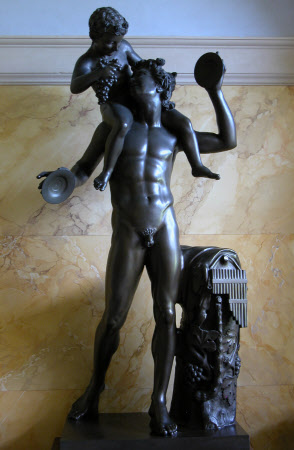The dancing faun with the infant Bacchus
Sabatino de Angelis (b.1838)
Category
Art / Sculpture
Date
1889
Materials
Bronze
Measurements
1880 mm (74 in) high
Place of origin
Naples
Order this imageCollection
Hatchlands Park, Surrey
NT 1166746
Summary
Sculpture, bronze; the dancing faun with the infant Bacchus; Naples, Sabatino de Angelis foundry, after the antique marble; 1889. A full-size cast of a Roman marble figure formerly in the Farnese collection and today in the collections of the Museo Archeologico Nazionale in Naples. Sabatino de Angelis, in whose foundry the bronze statue was cast, was one of the best of a number of Neapolitan sculptors in the later nineteenth and early twentieth centuries, who set up bronze foundries to meet the demand for copies of famous antiquities, especially but not just those being discovered in Pompeii and Herculaneum. The group of five bronze casts at Hatchlands is an impressive representative example of this fashion in the decades around 1900.
Full description
A full-sized bronze cast of a Roman marble figure depicting a young faun carrying on his shoulders the infant Bacchus (Greek, Dionysus), the classical god of wine. The naked faun holds a pair of cymbals and looks up towards Bacchus, who clasps a large bunch of grapes in his right hand. To the side of the faun’s left lag and partly attached to it, is a tree trunk, around which grows a vine plant heavy with grapes. Wrapped over or hanging from the trunk are an animal skin, a wooden club and a set of pan-pipes. The rectangular base is separately cast, with the signature and date applied to the surface at the back, behind the tree trunk. The statue of a faun with the infant Bacchus was discovered in the forum in Rome and was first recorded in the collection of the powerful Farnese family, which formed one of the great collections of ancient sculpture and paintings and works of art in Renaissance Rome. In the later eighteenth century the sculpture was sent to Naples. Together with many other ancient sculptures from the Farnese collection, the Young Faun with the Infant Bacchus is today in the collection of the Museo Archeologico Nazionale in Naples (Inv. 6022; Naples 1989, II, pp. 156-57, no. 19). It is today regarded as a Roman copy of a Greek original from the third century BC. The foundry operated in Naples by Sabatino de Angelis (1838 – c. 1915) was established in 1840, presumably by Sabatino's father. Sabatino de Angelis and Son became, along with the Chiurazzi and Giorgio Sommer, one of the most successful and best-known of the Neapolitan foundries capitalising on the huge international demand in the later nineteenth century for high-quality copies of antiquities from Herculaneum, Pompeii, Rome and elsewhere. The demand for these copies increased exponentially, after the Italian government agreed in 1860 to allow the making of copies of objects in the collections of the archaeological museum in Naples. All three foundries published catalogues of the products they offered, the 1900 catalogue from Sabatino de Angelis proudly proclaiming on its cover that the firm supplied casts to various European royal houses, as well as leading museums in London, Edinburgh, Glasgow, Boston, Chicago, New York and elsewhere. In the 1870s, Sabatino de Angelis also entered into a joint venture with the rival Chiurazzi foundry, forming the Fonderie Artistiche Riunite, the main purpose of which was to cater for the burgeoning American market. It also published a catalogue in 1910, largely based on the 1900 de Angelis catalogue, suggesting that it was Sabatino De Angelis who provided the majority of the models for the joint venture. It certainly appears to be the case that de Angelis was especially highly regarded internationally, the American curator Edward Robinson writing in 1892 that Sabatino De Angelis was ‘by far the best of the numerous Neapolitan copyists, his talent and feeling for his line of work being rare in any generation.’ (Edward Robinson, ‘Casts for the Metropolitan Museum of New York’, American Architect and Building News, 37 no. 872, 10 September 1892, pp. 166-68, p. 167). An indication of the perceived importance of this model was the fact that casts were offered in a much greater number of sizes than was usual with the Neapolitan foundries. The Fonderie Artistiche Riunite offered the original size, 188 cms., and then a whole series of reductions, 123, 85, 62, 38, 32 and 15 cms. It was available in two patinations, the dark-brown described as ‘Herculaneum’ or the richer and brighter colour described in the company’s catalogues as ‘moderne’. The five impressive casts at Hatchlands were probably all acquired by Harry Goodhart-Rendell’s grandfather Stuart Rendel, 1st Baron Rendel (1834-1913) to furnish the entrance hall at Hatchlands, after he had bought the house in 1888. Jeremy Warren October 2023
Provenance
Presumably acquired by Stuart Rendel, 1st Baron Rendel (1834-1913), c. 1890; by descent to Harry Stuart Goodhart-Rendel (1887-1959), by whom given in 1958.
Marks and inscriptions
Surface of base, behind tree-trunk:: Sabatino 1889 / Napoli
Makers and roles
Sabatino de Angelis (b.1838) , founder Sabatino De Angelis & Fils (Naples 1840 - 1915), founder
References
Sabatino 1900: Catalogue illustré de Sab. De Angelis et fils, Naples, Naples 1900, p. 72, no. 6022. Chiurazzi and De Angelis 1910: Fonderie Artistiche Riunite. J. Chiurazzi & Fils – S. De Angelis & Fils. Bronzes, Marbres, Argenterie, Naples 1910, p. 162, no. 6022. Naples 1989: Renata Cantilena et al., Le Collezioni del Museo Nazionale di Napoli, 2 vols., Rome 1989, II, pp. 156-57, no. 19

